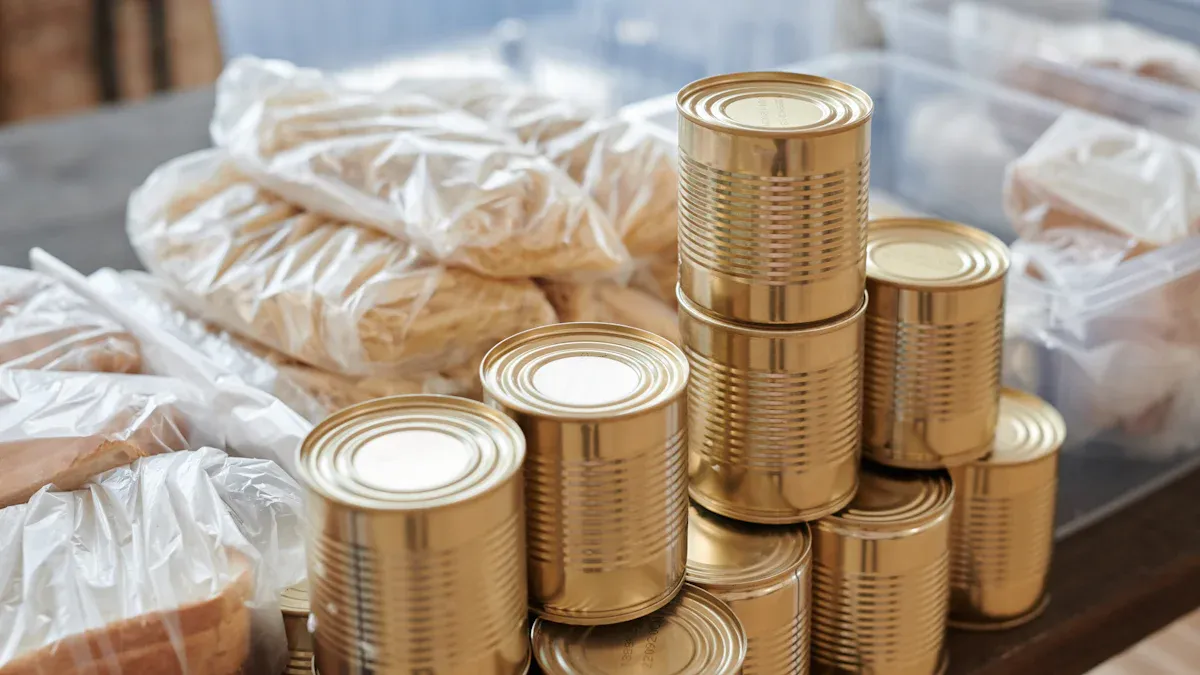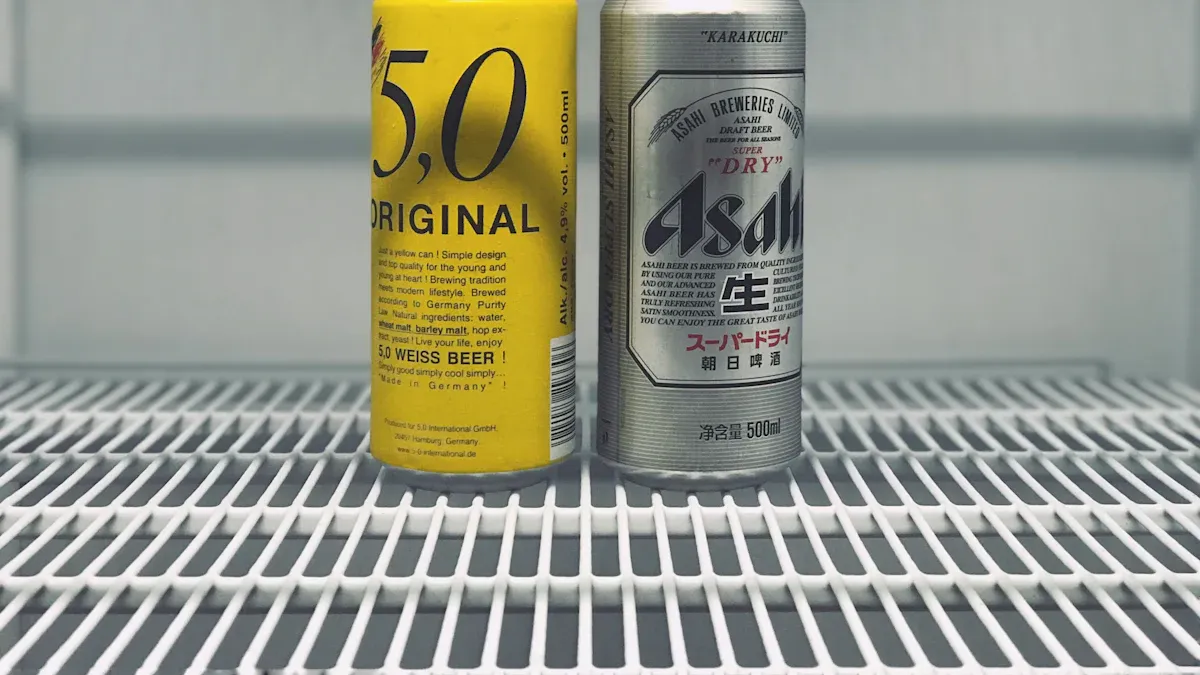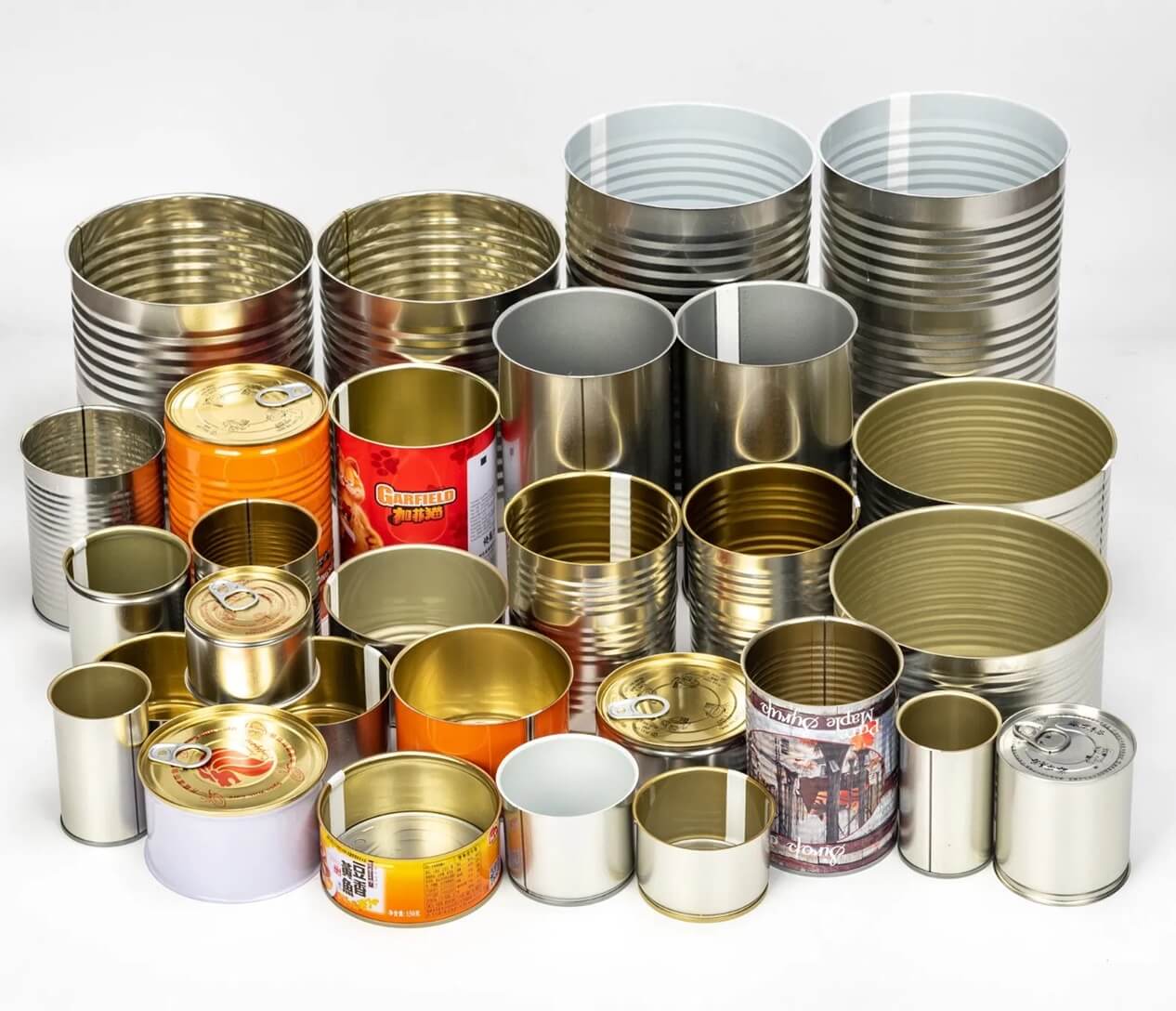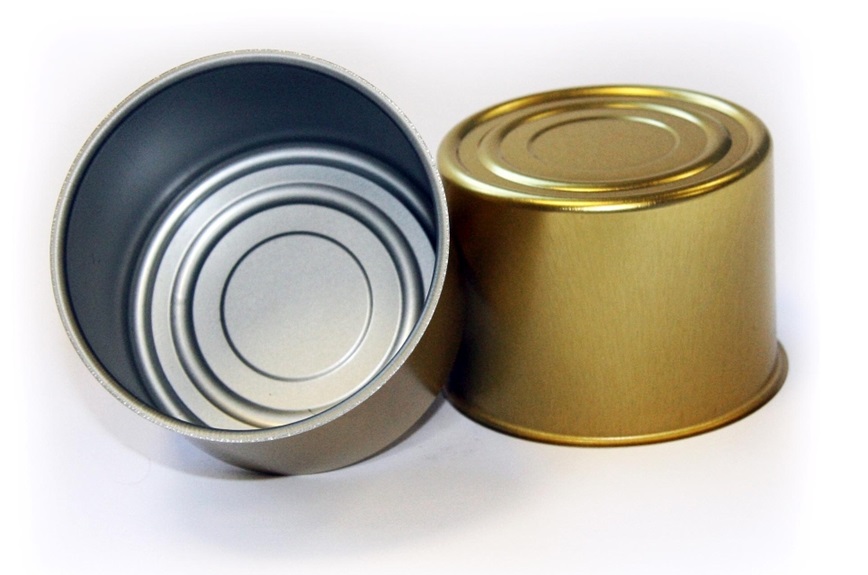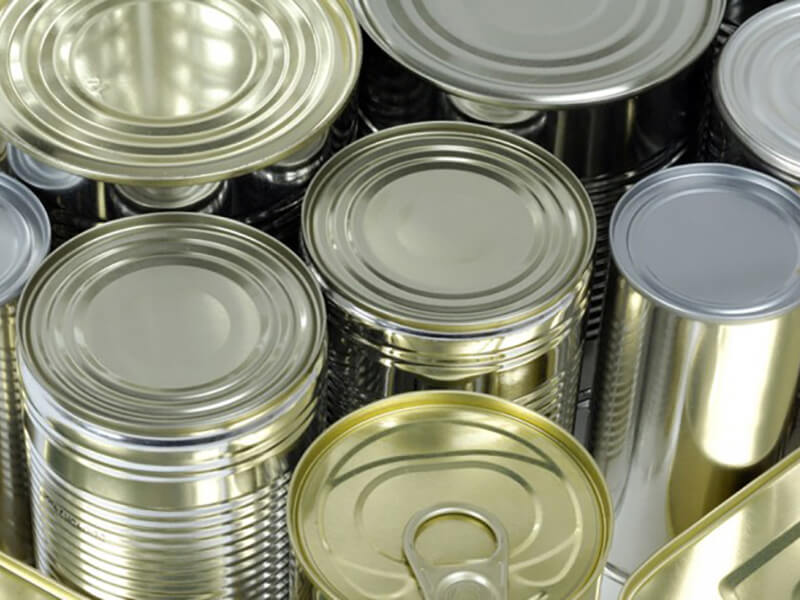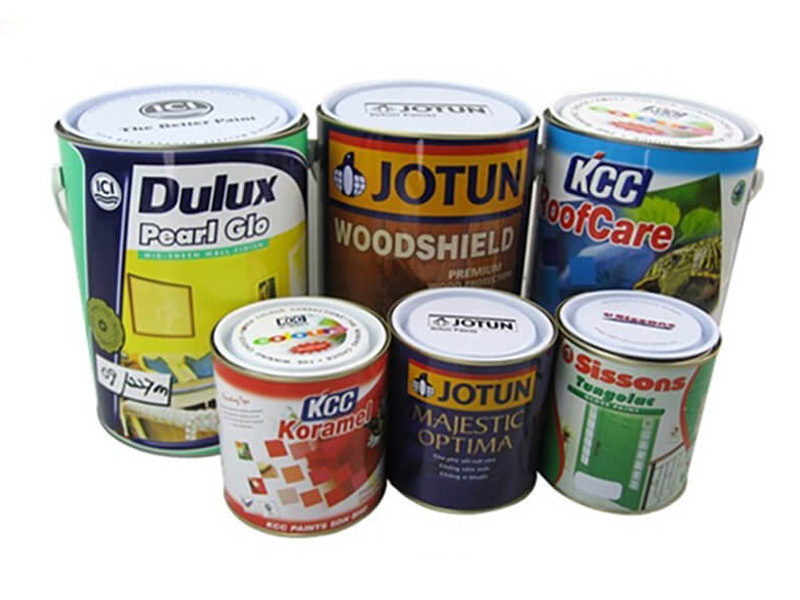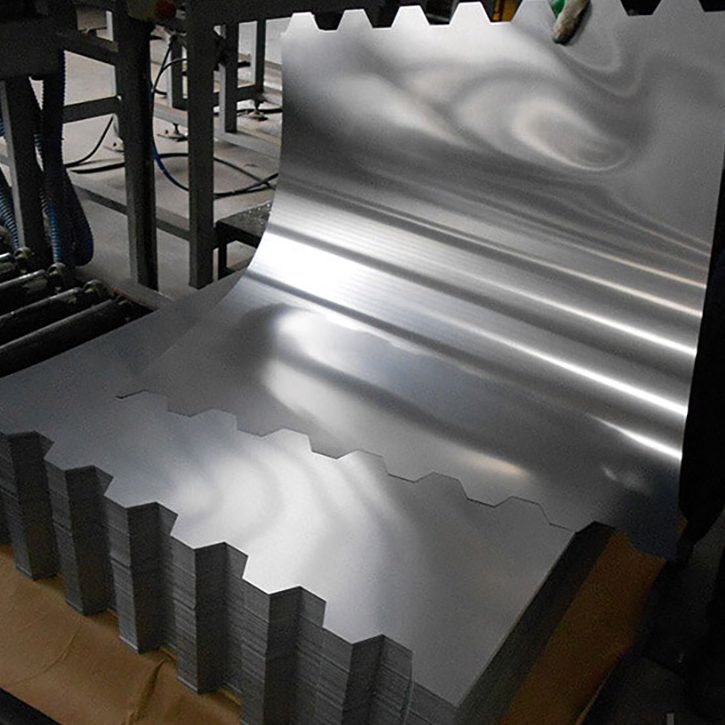A 3 pieces can is a highly reliable packaging solution made up of three components: a cylindrical body, a top lid, and a bottom lid. These 3 pieces cans are widely recognized for their robust construction, which involves sealing the body with a seam and attaching the lids using advanced rolling techniques. Their significance in packaging spans across food, beverages, and industrial products, offering unmatched durability and protection for contents.
The demand for 3 pieces cans continues to grow globally. For instance:
- The market size for 3 pieces metal cans is expected to rise from USD 20 billion in 2023 to USD 30 billion by 2032.
- This growth reflects a steady compound annual growth rate (CAGR) of 4.5%.
- The increase is fueled by the rising need for sustainable packaging and the growing consumption of canned goods.
You can rely on the versatility of these 3 pieces cans for various applications, from preserving food to storing chemicals. Their ability to adapt to diverse industries makes them an indispensable choice in modern packaging.
Key Takeaways
- 3-piece cans have a round body, a top, and a bottom. They are strong and protect many products.
- The use of 3-piece cans is growing worldwide. This is because people want eco-friendly packaging and canned foods.
- These cans are tough and keep food, drinks, and other items safe and fresh.
- They are made from materials like tinplate, aluminum, or steel with special coatings. These materials resist rust and can be recycled.
- There are three main types: welded, soldered, and glued cans. Each type works best for certain uses.
- Companies can design 3-piece cans in different shapes and styles. This helps make their products stand out to buyers.
- Metal cans can be recycled, which helps protect the environment.
- Picking the right 3-piece can for a product saves money and works better.
What Are 3-Pieces Cans?
Construction and Design
Cylindrical body with a seam
A 3-piece can is constructed by forming a flat sheet of metal into a cylindrical shape. The edges of the sheet are joined together using welding, soldering, or adhesive bonding to create a seam. This seam ensures the structural integrity of the can, allowing it to withstand internal pressure and external forces. The cylindrical body provides a uniform shape, making it ideal for stacking and storage.
Top and bottom lids sealed with a rolling process
The top and bottom lids are attached to the cylindrical body through a rolling process known as double seaming. This process involves bending and interlocking the edges of the lids with the body, creating a tight seal. Double seams are essential for preventing leaks and maintaining the freshness of the contents. This design also allows the can to endure rigorous handling during transportation and storage.
Did you know? The construction of a 3-piece can involves five key stages:
- Forming a tube and welding or soldering the seam of the sides.
- Joining the bottom end to the tube.
- Printing or attaching labels to the can.
- Filling the can with content, followed by sterilization or retorting for food products.
- Joining the wall and top “end.”
Materials Used
Tinplate (tin-plated steel)
Tinplate is the most commonly used material in 3-piece cans. It consists of a thin steel sheet coated with a layer of tin. This coating provides excellent corrosion resistance and ensures the can remains safe for food and beverage storage. Tinplate also offers a shiny, attractive appearance, making it suitable for decorative packaging.
Aluminum
Aluminum is another popular material for 3-piece cans. It is lightweight, corrosion-resistant, and highly recyclable. Aluminum cans are often used for specialty products and beverages, as they provide a premium look and feel.
Chromium-coated steel
Chromium-coated steel, also known as tin-free steel, is an alternative to tinplate. It offers similar strength and durability but is more cost-effective. This material is commonly used in industrial applications, such as packaging for paints and chemicals.
Key Features of 3 Pieces Can
Durability and strength
3-piece cans are known for their exceptional durability. The metal construction provides high resistance to impact, ensuring the contents remain protected during transportation and storage. These cans can also withstand high internal pressures, making them suitable for carbonated beverages and other pressurized products.
Recyclability and environmental benefits
Metal packaging, including 3-piece cans, is highly recyclable. Recycling metal reduces the need for raw materials and minimizes environmental impact. By choosing 3-piece cans, you contribute to a more sustainable packaging solution.
Customizability in shape and size
One of the standout features of 3-piece cans is their versatility. Manufacturers can produce these cans in various shapes and sizes to meet specific requirements. Whether you need a tall, slim can for a beverage or a wide, short can for a ready-to-eat meal, the design possibilities are endless.
Tip: The metal food and beverage can market continues to grow due to the adaptability of 3-piece cans. Their ability to cater to diverse industries makes them a preferred choice for manufacturers worldwide.
Types of 3 Pieces Can
Welded 3 Pieces Can
Features of welded cans (seam created using resistance welding)
Welded 3-piece cans are constructed using resistance welding, a process that joins the edges of the cylindrical body by applying heat and pressure. This method creates a strong, seamless bond that ensures the can remains leak-proof and durable. The welded seam enhances the structural integrity of the can, making it suitable for packaging products that require long shelf lives. Additionally, the welding process eliminates the need for soldering materials, reducing potential contamination risks.
Resistance welding also supports high-speed production, allowing manufacturers to produce large quantities of cans efficiently. This efficiency makes welded 3-piece cans a cost-effective solution for industries that require scalable packaging options.
Common applications (food and beverage packaging)
Welded 3-piece cans are widely used in food and beverage packaging due to their durability and ability to preserve contents. These cans provide a hermetic seal that extends the shelf life of perishable goods by up to five years. This feature is particularly valuable in regions with limited access to refrigeration.
You will often find welded cans used for canned vegetables, soups, and ready-to-eat meals. Their robust construction also makes them ideal for carbonated beverages, as they can withstand the internal pressure without compromising the seal. Advances in coating technologies, such as BPA-free linings, further enhance their suitability for food and beverage applications.
Key Benefits of Welded 3-Pieces Cans:
- Cost efficiency: Steel, the primary material, costs around $700–$900 per metric ton, making these cans affordable for mass production.
- Durability: The hermetic seal ensures product safety and longevity.
- Branding potential: High-quality digital printing and coatings allow for attractive, customizable designs.
Soldered 3 Pieces Can
Features of soldered cans (seam created using tin soldering)
Soldered 3-piece cans are made by joining the edges of the cylindrical body using tin soldering. This traditional method involves melting a tin-based alloy to create a seam. While soldering was once the standard technique for manufacturing 3-piece cans, it has become less common due to advancements in welding and adhesive technologies.
The soldered seam provides a reliable seal, but it may not match the strength and durability of welded seams. Additionally, concerns about lead contamination from older soldering methods have led to a decline in their use. Modern soldered cans typically use lead-free soldering materials to address these safety concerns.
Common applications (historical use, now less common due to lead concerns)
Historically, soldered 3-piece cans were used extensively for food and beverage packaging. They played a crucial role in preserving food during wartime and in regions with limited access to fresh produce. However, due to the potential health risks associated with lead-based soldering, these cans have largely been replaced by welded and adhesive-bonded alternatives.
Today, soldered cans are primarily found in niche markets or as collectible items. For example, vintage soldered cans are often sought after by collectors for their historical value and unique designs.
Adhesive-Bonded 3 Pieces Can
Features of adhesive-bonded cans (seam created using adhesives)
Adhesive-bonded 3-piece cans utilize advanced adhesives to join the edges of the cylindrical body. This method eliminates the need for heat or soldering, resulting in a lightweight and environmentally friendly packaging solution. The adhesive seam provides a secure bond while maintaining the can’s structural integrity.
One of the key advantages of adhesive bonding is its versatility. Manufacturers can use this method to create cans in various shapes and sizes, catering to specific product requirements. Additionally, adhesive-bonded cans are often lighter than their welded or soldered counterparts, reducing transportation costs and environmental impact.
Common applications (lightweight packaging, specialty products)
Adhesive-bonded cans are ideal for lightweight packaging and specialty products. You will often find these cans used for items such as powdered beverages, specialty teas, and luxury gift packaging. Their customizable design options make them a popular choice for promotional items and branding initiatives.
These cans are also gaining traction in the food and beverage industry, particularly for products that do not require high-pressure resistance. For example, adhesive-bonded cans are commonly used for non-carbonated drinks like juices and iced teas.
Did you know? Adhesive bonding technology has evolved significantly in recent years, enabling manufacturers to produce cans with enhanced strength and durability. This innovation has expanded the range of applications for adhesive-bonded 3-piece cans.
Specialty 3 Pieces Can
Features of specialty cans (custom shapes and designs)
Specialty 3-piece cans stand out due to their ability to accommodate unique shapes and designs. Unlike standard cylindrical cans, these specialty options allow you to explore creative packaging solutions tailored to specific branding or product needs. Manufacturers achieve this by employing advanced forming techniques that mold the metal into distinctive shapes, such as square, oval, or even custom geometries. This flexibility ensures that your product packaging aligns perfectly with your brand identity.
The customization extends beyond shape. Specialty cans often feature intricate designs, vibrant colors, and high-quality finishes. These elements enhance visual appeal and create a premium look that attracts consumers. For instance, embossing and debossing techniques add texture to the surface, making the packaging more tactile and engaging. Additionally, specialty cans can incorporate advanced coatings and lacquers to ensure durability while maintaining their aesthetic quality.
To ensure the highest standards, manufacturers utilize precise thermal cure process control during production. This technique prevents under or over-curing of internal lacquer, ensuring food safety and maintaining the can’s integrity. Temperature profiling eliminates overheating risks, preserving both the strength of the packaging and the quality of printed designs. Process validation further guarantees compliance with FDA regulations, providing traceable reports that protect against warranty claims.
| Feature | Benefit |
|---|---|
| Thermal cure process control | Prevents under or over curing of internal lacquer, ensuring food safety. |
| Temperature profiling | Eliminates overheating risks, maintaining packaging strength and print quality. |
| Process validation | Provides traceable reports to comply with FDA regulations, protecting against warranty claims. |
Tip: Specialty 3-pieces cans offer a perfect balance of functionality and aesthetics, making them an excellent choice for products that require standout packaging.
Examples of specialty uses (gift packaging, promotional items)
Specialty 3-piece cans excel in applications where presentation matters most. Gift packaging is one of the most popular uses for these cans. Their customizable designs allow you to create packaging that feels luxurious and exclusive. For example, a high-end chocolate brand might use a heart-shaped can with embossed patterns to enhance its appeal during Valentine’s Day. Similarly, tea companies often package their premium blends in intricately designed specialty cans, adding a touch of elegance to their products.
Promotional items also benefit greatly from specialty cans. These cans serve as a powerful branding tool, helping you leave a lasting impression on your target audience. Companies frequently use them for limited-edition products or seasonal campaigns. For instance, a beverage company might release a holiday-themed can with festive designs to boost sales during the holiday season. The ability to print high-resolution graphics and incorporate unique finishes ensures that your promotional packaging stands out on store shelves.
Did you know? Specialty 3-piece cans are not just visually appealing but also practical. Their robust construction protects the contents, ensuring that your gift or promotional item reaches its recipient in perfect condition.
By choosing specialty 3-piece cans, you can elevate your product’s packaging to new heights. Whether you’re aiming to impress customers with a luxurious gift or create a memorable promotional campaign, these cans provide the perfect solution.
Advantages and Disadvantages of 3 Pieces Can
Advantages
High strength and durability
A 3 pieces can offers exceptional strength and rigidity, making it a reliable choice for packaging. The metal construction ensures that the can maintains its shape even under impact, reducing the risk of deformation. This durability protects the contents during transportation and storage, minimizing potential losses. For instance, tin cans are particularly effective at withstanding external forces, ensuring the safety of food and beverages.
| Aspect | Description |
|---|---|
| Strength and Rigidity | Tin cans maintain their shape under impact, reducing the risk of deformation and associated costs. |
| High Adaptability | The production speed allows for efficient manufacturing, meeting diverse consumer needs at lower costs. |
| Lightweight Nature | The lightweight design reduces transportation costs, making it economical for long-distance shipping. |
Cost-effective production
The production process of 3 pieces can is highly efficient, enabling manufacturers to produce them at scale. This efficiency translates to lower production costs, making these cans an economical option for businesses. The adaptability of the manufacturing process allows for quick adjustments to meet market demands, further enhancing cost-effectiveness. Additionally, the lightweight nature of these cans reduces transportation expenses, offering savings for long-distance shipping.
Versatility in design and size
One of the standout features of 3 pieces can is their ability to cater to diverse packaging needs. Manufacturers can customize the shape, size, and design of these cans to suit specific products. Whether you require a tall, slim can for beverages or a wide, short can for ready-to-eat meals, the possibilities are endless. This versatility makes 3 pieces can a preferred choice across industries, from food and beverages to industrial applications.
Tip: The growing demand for golden coatings in the Asia-Pacific region highlights the aesthetic appeal of 3-piece cans. Consumers are willing to pay a premium for these visually appealing designs, making them an excellent choice for branding and marketing.
Disadvantages
Potential for seam leaks if not properly sealed
The seam in a 3 pieces can, while essential for its construction, can pose a risk if not sealed correctly. Improper sealing may lead to leaks, compromising the integrity of the packaging. This issue underscores the importance of quality control during the manufacturing process. Advanced techniques like resistance welding and adhesive bonding have significantly reduced this risk, but it remains a factor to consider.
Heavier compared to 2-piece cans
3-piece cans are generally heavier than their 2-piece counterparts due to their construction. The additional material used for the seam and the separate top and bottom lids contribute to the weight. While this added weight enhances durability, it may increase transportation costs, particularly for bulk shipments. However, the lightweight nature of materials like aluminum can help mitigate this disadvantage.
Environmental concerns with certain materials
The production of 3 pieces can involves the use of metals like tinplate and aluminum, which require mining and processing. These activities can have environmental impacts, including resource depletion and greenhouse gas emissions. Additionally, fluctuating raw material prices and strict environmental regulations can affect production costs. Despite these challenges, the recyclability of metal packaging helps offset its environmental footprint, making it a more sustainable option compared to non-recyclable alternatives.
Note: The metal food and beverage can market continues to grow due to advancements in sustainable production methods. By choosing recyclable materials, manufacturers can address environmental concerns while meeting consumer demand for eco-friendly packaging.
Use Cases for Each Type of 3 Pieces Can
Food Packaging
Canned vegetables, fruits, and soups
3 pieces can are a cornerstone of the canned food market, offering unmatched reliability for preserving vegetables, fruits, and soups. Their robust construction ensures that the contents remain fresh and safe for extended periods, even in regions with limited refrigeration. The hermetic seal created during the double-seaming process prevents contamination and spoilage, making these cans ideal for long-term storage.
The food packaging industry relies heavily on 3-piece cans due to their durability and convenience. These cans withstand high temperatures during sterilization, ensuring that canned food and beverages retain their nutritional value and flavor. For instance, canned soups and fruits benefit from the airtight seal, which locks in freshness and extends shelf life.
| Evidence Type | Details |
|---|---|
| Market Segment | The food and beverage application segment is the largest market for three-piece cans. |
| Demand Drivers | Continuous growth in demand for canned foods and beverages. |
| Product Advantages | Convenience, durability, and long shelf life make them ideal for preserving food products. |
| Industry Trends | Rise of new product categories in beverages fuels the need for reliable can packaging. |
| Sustainability Focus | Metal cans are preferred over plastic due to being more environmentally friendly and recyclable. |
Ready-to-eat meals and sauces
For ready-to-eat meals and sauces, 3-piece cans provide a practical and efficient packaging solution. Their ability to endure high-pressure processing ensures that these products remain safe and shelf-stable. You will find these cans particularly useful for packaging sauces, as their metal construction prevents leaks and maintains the product’s quality. The convenience of opening and resealing some specialty cans further enhances their appeal for consumers seeking quick meal solutions.
Beverage Packaging
Non-carbonated drinks (e.g., juices, teas)
Non-carbonated beverages like juices and teas benefit greatly from the lightweight and recyclable nature of 3-piece cans. Aluminum cans dominate this segment, holding a significant market share due to their excellent stackability and high recyclability rates. These cans are easy to transport and store, making them a preferred choice for manufacturers and consumers alike.
The versatility of 3-piece cans allows you to package a wide range of beverages while maintaining their freshness and flavor. For example, iced teas and fruit juices packaged in these cans remain protected from light and air, preserving their taste and nutritional content. The growing demand for sustainable packaging further highlights the importance of metal cans in this sector.
Specialty beverages (e.g., energy drinks, craft beverages)
Specialty beverages, including energy drinks and craft beverages, often require packaging that reflects their premium quality. 3-piece cans offer the perfect solution, combining durability with customizable designs. You can use these cans to create eye-catching packaging that enhances your brand’s appeal.
Steel cans, known for their strength and long shelf life, are particularly suitable for craft beverages that require extended storage. Advances in coating technologies, such as BPA-free linings, ensure that the contents remain safe and uncontaminated. This makes 3-piece cans an excellent choice for specialty beverages that demand both functionality and aesthetics.
Industrial Applications
Paints, coatings, and adhesives
The industrial sector relies on 3-piece cans for packaging paints, coatings, and adhesives. These cans provide a secure and durable solution for storing chemical products, ensuring that their quality remains intact during transportation and storage. The metal construction of these cans prevents leaks and protects the contents from external factors such as moisture and air.
In the paint industry, 3-piece cans have gained popularity due to their ability to store various types of chemical paints without degradation. Their robust design ensures that the packaging can withstand the rigors of handling and shipping, making them a reliable choice for industrial applications.
Chemicals and lubricants
For chemicals and lubricants, 3-piece cans offer a safe and efficient packaging option. Their airtight seal prevents leaks and contamination, ensuring that the contents remain effective and safe to use. These cans are particularly useful for storing hazardous materials, as their metal construction provides an added layer of protection.
The rising demand for sustainable and durable packaging solutions in the industrial sector underscores the importance of 3-piece cans. By choosing these cans, you can ensure the safe storage and transportation of chemicals and lubricants while minimizing environmental impact.
Specialty Applications
Gift packaging for luxury items
When it comes to luxury items, presentation plays a crucial role in creating a memorable experience. Specialty 3-piece cans offer an elegant and durable solution for gift packaging. These cans allow you to elevate your product’s appeal with premium designs and finishes that exude sophistication. Whether you’re packaging gourmet chocolates, fine teas, or high-end cosmetics, these cans provide a luxurious touch that resonates with consumers.
The versatility of specialty cans enables you to customize every aspect of the packaging. You can choose unique shapes, such as oval or heart-shaped cans, to align with your brand’s identity. High-quality finishes, including metallic coatings and embossed patterns, add a tactile element that enhances the unboxing experience. For example, a gold-coated can with intricate floral embossing can transform a simple product into a coveted gift.
Tip: Incorporate seasonal designs into your specialty cans to boost sales during holidays and special occasions. A festive-themed can for Christmas or Valentine’s Day can make your product stand out on store shelves.
Luxury gift packaging also benefits from the durability of 3-piece cans. The metal construction protects delicate items from damage during transportation, ensuring that your product reaches customers in pristine condition. This reliability builds trust and reinforces your brand’s commitment to quality.
Custom promotional items for branding
Promotional items are a powerful tool for building brand awareness, and specialty 3-piece cans offer a unique way to leave a lasting impression. These cans serve as both functional packaging and a canvas for your brand’s message. By customizing the design, you can create promotional items that captivate your target audience and enhance your brand’s visibility.
Imagine launching a limited-edition product in a can featuring your logo, vibrant colors, and a catchy tagline. This approach not only grabs attention but also encourages customers to associate your brand with creativity and quality. Specialty cans also allow you to experiment with innovative designs, such as holographic prints or textured surfaces, to make your promotional items truly unforgettable.
| Feature | Benefit |
|---|---|
| Customizable designs | Aligns with your brand identity and marketing goals. |
| Durable construction | Ensures the promotional item remains intact and functional. |
| High perceived value | Enhances customer appreciation and loyalty. |
Did you know? Studies show that 83% of consumers are more likely to do business with a brand after receiving a promotional item. Specialty cans can help you capitalize on this trend by offering a premium and memorable giveaway.
Specialty 3-piece cans are ideal for promotional campaigns targeting specific events or demographics. For instance, a beverage company could release a summer-themed can for a music festival, while a cosmetics brand might create a floral-patterned can for Mother’s Day. These targeted efforts not only boost sales but also strengthen your brand’s connection with its audience.
By leveraging the versatility and aesthetic appeal of specialty 3-piece cans, you can create promotional items that stand out and drive customer engagement.
Comparison with Other Can Types
3 Pieces Can vs. 2-Pieces Cans
Differences in construction (seamless vs. seamed body)
The primary distinction between 3-piece and 2-piece cans lies in their construction. A 3-piece can consists of a cylindrical body with a seam, along with separate top and bottom lids. This design allows for flexibility in size and shape, making it suitable for various applications. In contrast, a 2-piece can is made from a single piece of metal, forming a seamless body with an attached bottom. The top lid is added later, creating a simpler structure with fewer weak points.
The seamless design of 2-piece cans enhances their leak-proof properties, making them ideal for beverages and other liquid products. However, the seamed body of 3-piece cans provides greater adaptability, allowing manufacturers to produce cans in custom shapes and sizes. This versatility makes 3-piece cans a preferred choice for packaging diverse products, from food to industrial goods.
Pros and cons of each type (weight, cost, durability)
When comparing the advantages and disadvantages of these two types, you’ll notice distinct trade-offs. The table below highlights key differences:
| Feature | 2-Piece Cans | 3 Pieces Can |
|---|---|---|
| Durability | Superior aesthetics and leak-proof | Robust construction for stacking |
| Cost | Higher initial setup costs | Flexible in size and design, often lower cost |
| Weight | Lightweight properties | Heavier due to multiple components |
2-piece cans excel in durability and lightweight properties, making them a popular choice for beverages. However, their production requires specialized technologies, leading to higher initial costs. On the other hand, 3-piece cans offer cost-effective production and greater design flexibility, though their heavier weight may increase transportation expenses.
Tip: If your priority is scalability and customizability, 3-piece cans provide a more adaptable solution. For lightweight and leak-proof packaging, 2-piece cans are the better option.
3 Pieces Can vs. Composite Cans
Material differences (metal vs. mixed materials)
The materials used in 3-piece and composite cans set them apart significantly. A 3-piece can is made entirely of metal, such as tinplate, aluminum, or chromium-coated steel. This metal packaging ensures durability, recyclability, and excellent protection against external factors like moisture and air.
Composite cans, on the other hand, combine materials such as paperboard, plastic, and metal. This mixed-material construction makes them lightweight and cost-effective. However, composite cans lack the rigidity and long-term durability of metal packaging. They are also less recyclable due to the difficulty of separating the materials during the recycling process.
Use case differences (food and beverage vs. dry goods)
The choice between 3-piece and composite cans often depends on the product being packaged. 3-piece cans are ideal for food and beverage applications, where durability and airtight seals are crucial. They excel in preserving perishable goods, such as canned vegetables, soups, and ready-to-eat meals.
Composite cans, however, are better suited for dry goods like snacks, powdered beverages, and cereals. Their lightweight design and cost-effectiveness make them a practical choice for products that do not require the same level of protection as food and beverages.
| Can Type | Pros | Cons |
|---|---|---|
| 3 Pieces can | Good rigidity, Easy to scale size, Can be adapted to different shapes, Adaptable to various materials | Higher material consumption, More potential weak points |
| Composite | Lightweight, Cost-effective, Suitable for dry goods | Limited durability, Less recyclable due to mixed materials |
Note: If your product requires long-term preservation or protection from external elements, 3-piece cans are the superior choice. For lightweight and budget-friendly packaging, composite cans offer a viable alternative.
3 pieces can packaging offers unmatched versatility, durability, and adaptability across industries. You’ve explored their construction, materials, and various types, each tailored to specific applications like food, beverages, and industrial products. Selecting the right can type ensures optimal performance and cost-efficiency for your business needs.
When considering packaging solutions, prioritize 3-piece cans for their strength, recyclability, and customizability. These cans not only protect your products but also enhance your brand’s appeal. By choosing this reliable option, you align with sustainable practices while meeting diverse market demands.
FAQ
What makes 3-pieces can different from other can types?
3 pieces can consist of a cylindrical body with a seam and separate top and bottom lids. This design allows for greater flexibility in size and shape compared to seamless 2-piece cans or composite cans made from mixed materials.
Are 3 pieces can recyclable?
Yes, 3 pieces can are highly recyclable. Their metal construction, often made from tinplate or aluminum, ensures they can be reused multiple times, reducing environmental impact and supporting sustainable packaging practices.
Can 3 pieces can be used for carbonated beverages?
Absolutely. Welded 3 pieces cans are strong enough to handle the internal pressure of carbonated beverages. Their durable construction and airtight seals ensure the contents remain fresh and safe during storage and transportation.
What industries benefit most from 3-piece can?
Food, beverage, and industrial sectors rely heavily on 3 pieces cans. They are ideal for packaging canned vegetables, soups, paints, chemicals, and even specialty items like luxury gifts or promotional products.
How customizable are 3 pieces can?
3 pieces can offer extensive customization options. You can choose from various shapes, sizes, and finishes. Advanced printing techniques allow for vibrant designs, making them perfect for branding and promotional purposes.
Are adhesive-bonded 3 pieces can as durable as welded ones?
Adhesive-bonded cans are durable for lightweight and specialty products. However, welded cans provide superior strength and are better suited for high-pressure applications like carbonated beverages or long-term food storage.
What materials are commonly used in 3-pieces can?
Manufacturers typically use tinplate, aluminum, or chromium-coated steel. These materials provide excellent durability, corrosion resistance, and recyclability, making them ideal for various packaging needs.
Why are 3 pieces can preferred for industrial applications?
Their robust construction and airtight seals make 3 pieces can perfect for storing paints, chemicals, and lubricants. They protect contents from contamination and ensure safe transportation, even for hazardous materials.
Tip: Always choose the right type of 3 pieces can based on your product’s specific requirements to maximize performance and cost-efficiency.




